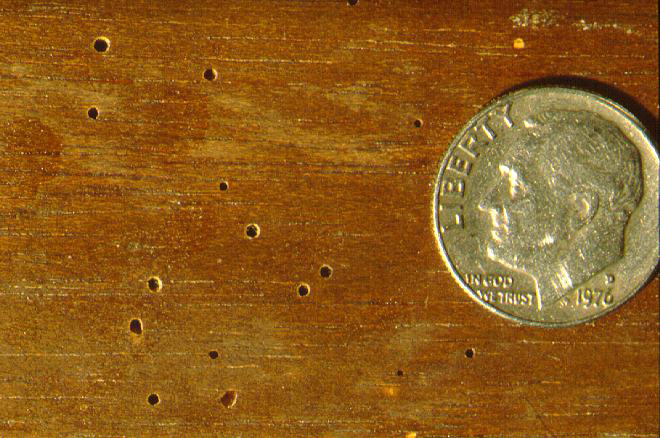Identification
The adult lyctid powderpost beetle is a small (3/32 to 1/4 inch-long), cylindrical, brown beetle that attacks hardwood. Damage caused by the powderpost beetle is usually first detected with the appearance of holes in wood, 1/32 – 1/16 inch-diameter, from which a very fine sawdust may fall. Larvae of the powderpost beetle feed on many of the various hardwoods used in furniture, baskets, hardwood trim and flooring. Infestations in homes are almost always due to infestation of the wood prior to construction.
Life cycle
Powderpost beetles pass through four distinct life stages: egg, larva, pupa and adult. The first three of these stages are found only in the infested wood. The larva is a creamy white, C-shaped grub with an enlarged thorax. The larval stage of the beetle is responsible for most of the actual feeding damage to the wood.

Adult lyctid powderpost beetles are dark, cylindrical beetles with spherical eyes, 3/32 – 1/4 inch long.
Outdoors, the life cycle of a powderpost beetle normally requires about a year; however indoors, powderpost beetles may require two or more (possibly up to five) years to complete their development and emerge from the wood. For this reason, infestations may not be detected for several months, or even years, after completion of a new home.
Damage
The most commonly infested woods include ash, oak, hickory and walnut. Although powderpost beetles pose little threat to the structural integrity of most homes (which are framed with softwood lumber, thus not susceptible to attack), it is a reportable wood destroying beetle and can affect property resale value. It is also possible, though unlikely, that such an infestation could spread to hardwood furniture, trim, paneling, or flooring if left untreated.
Female beetles emerging from infested wood search for a mate, and then lay their eggs on a suitable piece of wood. Powderpost beetles usually require unfinished wood (no paint or varnish coating the wood pores) in which to lay their eggs. However, the most common site for egg-laying indoors appears to be exit holes from which the females have emerged. In this way beetles can re-infest finished wood. Infestations can also spread internally to adjacent wood as larvae chew their way from one piece to another.
Control
The most economical control method is removal and replacement of all known-to-be infested wood pieces. Where damage is limited to a few pieces of wood, this is the simplest and most practical solution. Removing infested wood and replacing it with uninfested (preferably treated) wood will eliminate the problem in most cases. It can be difficult, however, to know whether all infested wood has been removed. For this reason it may be best to wait a period of time (say, 1-2 months) after an infestation is first noticed to allow time for all beetles in the wood to emerge and reveal the extent of the infestation.
Painting infested wood surfaces with a pesticide labeled for such use may be an option in some cases where wood can not easily be removed. However before insecticide can be applied, the wood to be treated must first be stripped of paint or other finishes. Treatment is then applied to the surface of the bare wood, and the wood refinished. This sort of treatment does not kill beetles that are deep in the wood–rather it kills adult beetles as they emerge. Applying borate salt solutions to unfinished wood rarely obtains good penetration of dry wood. Surface applications of these salts rarely penetrate more than fractions of an inch, offering little guarantee of eradication of a problem. Injection of liquid or foam formulations of borate salts into existing, or drilled, holes in the wood may be worth trying in situations where wood cannot be removed and replaced; but little research exists to support the effectiveness of such treatments.
Fumigation may be an option for treating individual pieces of furniture or, in extreme cases, entire homes. Fumigation of the whole home is a costly and inconvenient procedure that involves placing a gas-tight tent over the entire structure and injecting a gas that is capable of penetrating wood and killing beetles. Two or more days are generally required to air the home adequately before it can be re-occupied. Treatment costs can easily reach ten thousand dollars or more for a moderately sized home. For a property owner who requires a guarantee of complete elimination, or where infestations are widespread and untreatable by other methods, this is sometimes the only viable option.
For more information
For more information on lyctid beetles and other structural infesting wood beetles, request publication E-394, Structure Infesting Wood Beetles.
Author
Michael Merchant, Ph.D., Professor and Extension Urban Entomologist, Texas AgriLife Extension Service.
